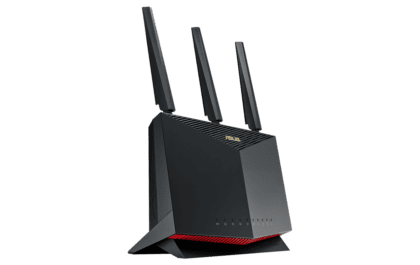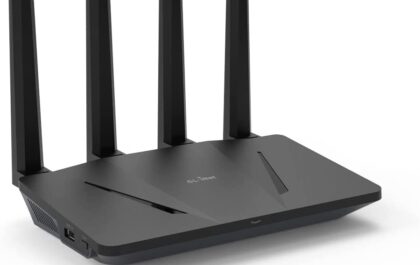


Are you one of those people constantly asking: Why is my Internet or Wi-Fi so slow? Most people generally refer to all Wireless Internet as Wi-Fi, but Wi-Fi is an oft misused term. Many are quick to blame their ISP for all of their internet problems. However, many times it all comes down to the type of router you are using and the speed it offers. Read on to see why you should ditch that old Wireless-N router and upgrade to a super-fast Wireless AC or a Wi-Fi 6 router!
If you’re looking for a great router that features some of the newest Wi-Fi technology, grab one of our FlashRouters today!

Asus RT-AX86U PRO Merlin FlashRouter – Great for Large Homes / Perfect for 15+ Devices / Blazing-fast Wi-fi 6 (Wireless-AX) Speeds / Enhanced with Merlin Upgraded Firmware Maintains + Builds on MOST Premium Asus Router Standard Features SALE PRICE: $304.99 $424.99 | BUY NOW

Flint Wi-Fi 6 VPN Router by FlashRouters – Supports WiFi 6 (Wireless-AX) speeds / Includes WireGuard Fast VPN Protocol Support / Features Built-in Ad-Block & DNS Encryption SALE PRICE: $164.99 $229.99 | BUY NOW
The wireless standard that we know today was created by the Institute of Electrical and Electronics Engineers or IEEE.
IEEE 802.11 is a wireless networking standard created to keep manufacturers of wireless routers and wireless networking devices (PlayStations, Laptops, Tablets, SmartTVs, Xboxes, iPhones, Roku) on the same page. These standards include IEEE 802.11a, 802.11b, 802.11g, 802.11n, 802.11ac, 802.11ad, and 802.11ax. So, what are these standards, and what do they have to do with you?
Wireless-G, also known as 802.11g, is an older wireless networking standard set by the IEEE. Mostly obsolete now, 802.11g offered speeds of up to 54 Mbps and was quickly adopted due to its upgrade in speed over 802.11b.
For example, you may notice that the speed in many coffee shops seem quite slow. This is because man run on slower Wireless-G (54 Mbps) routers, or even Wireless-B (11 Mbps). As a result, when so many people are constantly sharing the same connection, you get relatively low throughput speeds.
Wireless-N, also known as Wi-Fi 4, was created to improve network throughput (maximum speed and transmission capabilities) over the two prior standards—802.11b and 802.11g.
Wireless-N was a significant upgrade from Wireless-G for the following reasons:
While these features may have been an upgrade from Wireless-G, Wireless-N is mostly phased out. Luckily, new routers and wireless standards will still support Wireless-N and older wireless standards.
Looking for a router that supports your Wireless-N devices? Check out one of our most popular options!

Asus RT-AX86U PRO Merlin FlashRouter – Great for Large Homes / Perfect for 15+ Devices / Blazing-fast Wi-fi 6 (Wireless-AX) Speeds / Enhanced with Merlin Upgraded Firmware Maintains + Builds on MOST Premium Asus Router Standard Features SALE PRICE: $304.99 $424.99 | BUY NOW
Wi-Fi 5, also known as Wireless-AC, is one of the IEEE’s most popular wireless standards on the market today. The 802.11ac standard greatly improves nearly every aspect of Wireless-N.
Wireless-AC has increasingly become more formalized and is essentially the minimum for every wireless-capable device. Some improvements include:
For the best Wi-Fi 5 speeds, check out one of our most popular routers below:

Flint Wi-Fi 6 VPN Router by FlashRouters – Supports WiFi 6 (Wireless-AX) speeds / Includes WireGuard Fast VPN Protocol Support / Features Built-in Ad-Block & DNS Encryption SALE PRICE: $164.99 $229.99 | BUY NOW
Wireless-AD is among the newer wireless standards to hit the consumer market. As with any new wireless standard, nearly every aspect has been improved and upgraded. Some of these upgrades include:
However, Wireless-AD is not backward compatible. Simply put, there are few very Wireless-AD compatible devices that support the new 60 GHz frequency band.
 Fi 6 is the same as 802.11ax" width="200" height="200" />
Fi 6 is the same as 802.11ax" width="200" height="200" />
Unveiled at CES 2018, Wi-Fi 6, also known as Wireless-AX, is the next step in wireless standards. Wi-Fi 6 can deliver as much as five times the bandwidth as Wi-Fi 5. Current routers are equipped with 4×4 MU-MIMO (multi-user, multiple-input, and multiple-output), while wireless-AX Wi-Fi 6 routers will come standard with 8×8 MU-MIMO on both 2.4 GHz and 5 GHz bands. Essentially, Wireless-AX will support eight data streams up and down your network, doubling the previous standard.
Other upgrades from previous standards include: increased efficiency, reliability, and better coverage in large areas. While these specs sure do look enticing, Wi-Fi 6 routers are generally more expensive and are less customizable than Wi-Fi 5 routers. Additionally, these are mostly software upgrades and not a 6Ghz band as most anticipated.
Hanging onto an older Wireless-G or Wireless-N router means you are sacrificing overall speed and security while actually hindering the wireless capabilities for newer devices.
Using a Wireless-G or Wireless-N router with your iPad may feel like trying to catching a fish with a stick. It may work, but you’ll feel like you’re back on dialup! New wireless standards mean MAJOR wireless connectivity improvements. Best of all, newer routers are fully backwards compatible with older devices, so you’ll always be able to connect every device to the internet!
At FlashRouters, we offer state-of-the-art routers that feature fully customizable firmware from the most popular firmware project like DD-WRT, Merlin, and more. While off-the-shelf routers often have features hidden, we unlock those secret benefits for you! Now, you’ll have more control over your Wi-Fi signal and improved signal strength, as well as full VPN integration at the tip of your fingers! Get one of our customer favorites today!